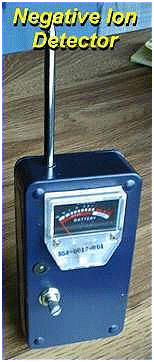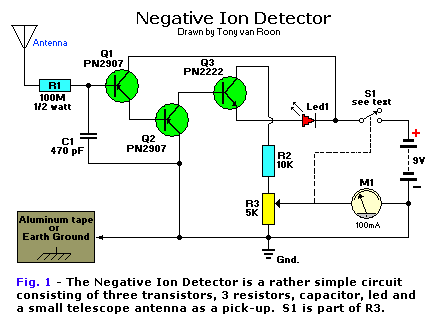
Build this Negative Ion Detector
by Vincent Vollono
Ions are defined as electrically charged atoms. Positively charged ions
have a deficiency of electrons, and negatively
charged ions have a surplus of electrons. An ion can also be classified as an atom or molecule with an electrostatic
charge. Another classification of an ion is a charged particle that is formed when one or more electrons are taken
from or added to a previously neutral atom or molecule.
The Ion Detector described in this article can be used to detect the presence of free ions in the air. The Ion
Detector, a handheld unit about the size of a pack of cigarettes, is designed to indicate ion emissions from Ion
Generators, high-voltage leakage points, static-electricity sources, electric-field gradients, and in other situations
where the presence of their relative flux density is required.
The front cover features, a sensitivity control with on-off switch, a high flux indicator lamp, and a panel meter. An
antenna, mounted on the top of the unit, serves an external ion collector. A strip of metallic foil on the outside of
the plastic enclosure touches the users hand and is used to ground the unit. For fixed applications, the strip can be
replaced by a wire connected to the ground.
Circuit Description:
Figure 1 shows a schematic diagram of the Ion Detector--a rather simple circuit consisting
of three transistors (two PN2907 PNP, and a single PN2222 NPN type), three resistors, one capacitor, an antenna, a mA
meter, and an Led.
In that circuit, a telescoping antenna is used as the pickup. In the presence of an ion field, ions accumulate on the
antenna, causing a minute negative current to flow to the base of Q1. Capacitor C1 and resistor R1 form an RC network,
whose function is to eliminate any rapid fluctuations. Once the negative current becomes large enough, it causes Q1 to
turn on, connecting the negative terminal of battery B1 to the base of Q2. That forward biases Q2, causing it to turn
on. That, in turn, couples the base of Q3 to the positive terminal of the battery, forward biases Q3 - whose collector
is in series with current-limiting resistor R2 and meter-sensitivity control R3 - causing it to conduct.
 With Q3 turned on, meter M1 indicates (in a non-linear
manner) the relative level of ion flux, while LED1 (which is
connected in series with Q3's emitter) lights to give a visual indication of strong ion fields. It should be noted that
in order for the unit to operate properly, some sort of ground is usually required.
With Q3 turned on, meter M1 indicates (in a non-linear
manner) the relative level of ion flux, while LED1 (which is
connected in series with Q3's emitter) lights to give a visual indication of strong ion fields. It should be noted that
in order for the unit to operate properly, some sort of ground is usually required.
Metallic tape is used in the prototype to provide a convenient contact for the users hand, thereby providing a partial
ground. If possible, such as when the unit is used as a monitor at a permanent location, the detector should be
grounded to a water pipe, or some other convenient grounding point.
The detector is set up to detect negative ions. It can be made to detect positive ions by simply reversing the polarity
of the transistors that comprise the circuit, i.e., PNP units become NPN units, and NPN transistor is replaced by a PNP
unit. I should note that the performance of the detector is seriously affected by high humidity. Damp or moist air tends
to impair the circuits ability to detect ion flux.
Parts List:
R1 = 100M, 1/2W, 5%
R2 = 10K, 1/4W, 5%
R3 = 5K, potentiometer (see text)
C1 = 470pF, ceramic disc
Led1 = Led, red, 5mm
Q1,Q2 = PN2907 or NTE159M, try others like 2N2907
Q3 = PN2222 or NTE123AP, try others like 2N2222
M1 = 100mA, panel meter
Additional Parts and Materials:
Perfboard, plastic enclosure, 9-volt battery holder and connector, wire, solder,
hardware, etc.
R1 Note: We couldn't find a 100-mega-ohm resistor. We used (5) 20-mega-ohm
resistors in SERIES to get 100-mega-ohms.
The Ion Detector can be used to give a quick indication of the presence of a negative ion field, aid in identifying its
source, and indicate its relative strength, but it is not designed to provide an absolute measurement of flux intensity.
The circuit can also be used to aid in making adjustments to ion sources, by noting the meter's needle deflection as
you attempt to increase or decrease ion emissions. The Ion Detector can also be used to ferret out residual ion fields,
check for ion leakage (in shielding tests, for example), or to test for static charges (in people's clothes, fluorescent
lighting, plastic containers, certain winds, etc.), along with a host of other applications.
Construction:
The author's prototype of the Ion Detector was assembled on a section of perfboard, using point-to-point wiring for
inter component connections. Pay close attention to the orientation of the polarized components (Led, transistors,
meter, etc.), as well as the polarization of the DC source that will power the circuit when assembling the circuit.
It is very important that you verify all your interconnecting wiring.
It is highly recommended that the circuit be enclosed in a plastic project box. Once the circuit is completed, a 1/2
inch wide strip of aluminum is attached to the side of the enclosure, and is then connected to the circuit board (at
the junction of C1, the positive lead of the panel meter, and the positive terminal of the battery) as shown in Fig. 1.
The aluminum strip serves as the circuit's grounding point. The grounding strip can be replaced or supplemented by a
wired alligator clip for connection to a "true" earth ground (a water pipe, for example).
The author used a telescoping antenna as the ion pickup in his prototype unit; however, a piece of stiff wire (like piano
wire, for example) would also work. In either case, the antenna must be electronically isolated; i.e., it should not be
connected to ground in any way. Note that S1 (the on-off switch) is piggy-backed to potentiometer R3 (a 5K
potentiometer that serves as the meter's sensitivity control). You can also use a potentiometer with a piggy-back
switch or use two separate components.
For meter M1, the author used a small 100-mA panel meter; using a meter with a rating other than that specified may
affect the performance of the unit. It is also important to remember that any leakage around the input of Q1 will
reduce the circuit's sensitivity. To help prevent (or at least reduce) leakage, the circuit can be coated with a
high-quality varnish. If you decide to coat the circuit, make sure that the unit is completely clean and dry before
applying the varnish.
How to use it:
To demonstrate the unit's sensitivity, run a plastic comb through your hair, and place it near the antenna
of the Ion Detector. Making sure that the unit is grounded (either by the user touching the aluminum strip or by
connecting an earth ground to the circuit), bring the comb near the antenna. As the comb is brought near the antenna,
you'll note a needle deflection on the meter (indicating the presence of ions), and LED1 lights. As the detector is
brought closer to the ion source, the meter needle should deflect harder. If the needle deflects too hard (pegs), R3
can be adjusted to bring the meter reading on scale. That's all there is to it. While the Ion Detector is not a
precision instrument, it can come in handy in your workshop or laboratory.
Please Note: When using to check Negative Ionizer generator operation, NEVER let
the antenna of the ion detector touch needle tips of the ionizer. If the Negative Ionizer is working and producing a
lot of negative ions, it will show up on the Ion Detector as far away as 1 to 10 feet from the Negative Ionizing unit.
Copyright and Credits
This article is copyright by the author, Vincent Vollono, and first published in the 1994 spring issue of "Electronics
Hobbyists Handbook", published by Gernsback Publishing (no longer in business).
Back to High Voltage Projects Index
Copyright © 2005 - Tony van Roon

 With Q3 turned on, meter M1 indicates (in a non-linear
manner) the relative level of ion flux, while LED1 (which is
connected in series with Q3's emitter) lights to give a visual indication of strong ion fields. It should be noted that
in order for the unit to operate properly, some sort of ground is usually required.
With Q3 turned on, meter M1 indicates (in a non-linear
manner) the relative level of ion flux, while LED1 (which is
connected in series with Q3's emitter) lights to give a visual indication of strong ion fields. It should be noted that
in order for the unit to operate properly, some sort of ground is usually required.